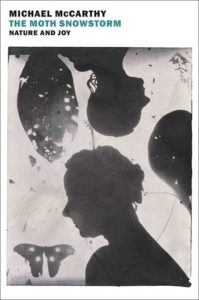The Moth Snowstorm: Nature and Joy
Reviewed by Ruah Swennerfelt
June 1, 2017
 By Michael McCarthy. New York Review Books, 2016. 273 pages. $24.95/hardcover; $14.99/eBook.
By Michael McCarthy. New York Review Books, 2016. 273 pages. $24.95/hardcover; $14.99/eBook.
Buy from QuakerBooks
“People from a planet without flowers would think we must be mad with joy the whole time to have such things about us.” —Iris Murdoch, A Fairly Honourable Defeat
The Moth Snowstorm is not about moths, but instead is part autobiography, part nature journal, and mostly about finding joy in nature. The author begins by remembering outings with his family as a young child when, in the evening when the headlights were turned on, so many moths appeared that it was like a snowstorm, and his father had to get out several times to wipe their bodies off the lights. McCarthy writes that the phenomenon no longer exists due to the “great thinning” of so many small creatures in the years since. In this book, McCarthy shares much about his youth and discovery of incredible natural places that sparked a love of nature and secured for him the outdoors as a place of nurture.
Although he spends a considerable amount of time reminding us of the crisis we face in a world subjected to agricultural pesticides and herbicides and other follies of humankind, McCarthy also shares many wonderful stories of joy and wonder about butterflies, birds, flowers, and so much more. As he takes us through the annual calendar of events on his island home of England, he shares, “I can think of nothing more extraordinary and exceptional than the annual rebirth of the world: and in fact, there are a number of specific markers of the rebirth, of the earth’s reawakening after winter . . . which I celebrate in my heart.”
McCarthy shares a story about an encounter with woodland bluebells, an encounter that was a “sort of ecstasy” because of the intensity of the blue color. He kept returning to those woods, five days in a row, to revel in them, until they began to fade. And he shares his experience of the dazzling blue of the morpho butterflies in South America. I know that dazzle. The summer I turned 12, I lived in Panama, where an aunt and uncle of mine lived. The freedom we children had, exploring the nearby jungles and traipsing to the Panama Canal, just couldn’t be replicated today. I remember walking into the dense growth and feeling such awe at those giant butterflies. It’s still a vibrant memory some 58 years later.
The last three chapters are titled, “Joy in the Beauty of the Earth,” “Wonder,” and “A New Kind of Love.” They focus on the importance of the relationship we can have with the natural world and how we can feel such delightful renewal when we take the time to explore, walk, appreciate, and revel in what the world has to offer. His stories of joy, awe, and wonder are inspiring.
I can’t really portray in such a short space the importance of this book. If you’re a birder, hiker, explorer, or just love to be surrounded by natural beauty, this is a book for you. But just beware that McCarthy does give us cause for concern for the planet’s future. And isn’t that important for us to know? Might it inspire us to try to protect what is so wonderful?
I’ll close with McCarthy’s words:
That the natural world can bring us peace; that the natural world can give us joy: these are the confirmations of what many people may instinctively feel but have not been able to articulate; that nature is not an extra, a luxury, but on the contrary is indispensable, part of our essence. And now that knowledge needs to be brought to nature’s defence.



Comments on Friendsjournal.org may be used in the Forum of the print magazine and may be edited for length and clarity.